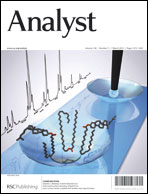Flow injection chemiluminescence immunoassay of microcystin-LR by using PEI-modified magnetic beads as capturer and HRP-functionalized silica nanoparticles as signal amplifier†
Abstract
A rapid sandwiched immunoassay of microcystin-LR (MC-LR) in water is proposed with flow injection chemiluminescence detection. The magnetic beads (MBs) were first modified with polyethyleneimine (PEI) by acylamide bond between the carboxyl group on the surface of MBs and the primary amine group in PEI, followed by immobilizing of anti-MC-LR (Ab1) onto PEI with glutaraldehyde as linkage. The resulting Ab1 modified MBs captured the target MC-LR in water, reacted with the horseradish peroxidase and anti-MC-LR co-immobilized silica nanoparticles, and were detected with flow injection chemiluminescence. When using PEI/MBs as the carrier of anti-MC-LR, the CL signal was greatly enhanced up to 9-fold compared to that using MBs without PEI modification. The CL signal was further amplified 13-fold when Si/Ab2 was used as the signal probe. Under the optimal conditions, the present immunoassay exhibited a wide quantitative range from 0.02 to 200 μg L−1 with a detection limit of 0.006 μg L−1, which was much lower than the WHO provisional guideline limit of 1.0 μg L−1 for MC-LR in drinking water. The relative standard deviation was 4.8% and the recoveries for the spiked samples ranged from 84% to 115%, which indicated acceptable precision and accuracy for MC-LR. The present method is easier to perform and less time-consuming (the entire analysis process lasted about 40 minutes) and has been applied to the detection of MC-LR in different water samples successfully.


 Please wait while we load your content...
Please wait while we load your content...